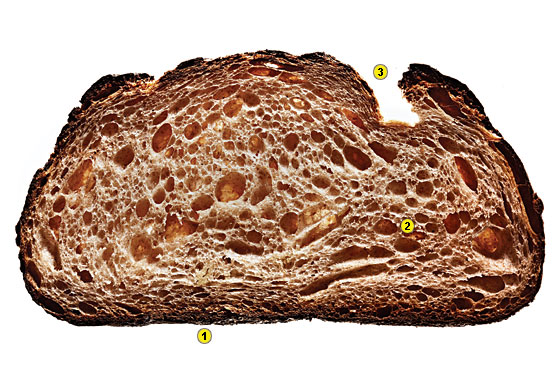
It’s pretty amazing that by tossing together some flour, water, yeast, and salt and eventually baking the mixture, you get something as magnificent as bread. Of course, it’s infinitely more complicated than that. And, of course, results vary: There are superb breads, and there are not-so-superb breads. How to tell the difference? Narrowing down the field to European hearth-style loaves—in other words, one popular category of artisan bread—we’ve identified a few telltale signs.
1. A Dark and Crackly Crust
Aside from the obvious textural appeal of a crisp and crackly crust combined with a tender, springy crumb, dark color is usually a good sign that the interior of the loaf is going to have more and better flavor. Simply put, in the late stages of baking, all those delicious, toasty, caramel-y, nutty, malty, Maillard-reaction flavors developing on the dough’s surface infiltrate the interior, resulting in an overall tastier loaf. How dark is too dark? Depending on the type, some of the best bread out there (like Roberta’s City White loaf) can be as black as a piece of burnt toast.
2. A Weird and Wild Hole Structure
You can tell a lot about a loaf of bread by examining its crumb, or interior. Bread nerds study the crumb’s hole structure the way jewelers on 47th Street study diamonds. What you’re looking for is this: an intricate gluten network or webbing of irregularly patterned holes, ranging in size from small to fairly gaping. The more wildly inscribed and chaotic the hole structure, the better the bread. Why? Because such a structure indicates that the dough has been properly kneaded (aerated) and/or given the luxury of a long fermentation time, both of which lead to the development of the carbon-dioxide-gas bubbles that inflate the air pockets in the dough and allow for a light and tender loaf. Such a structure also affords the best opportunity for oven heat to fully penetrate the grain and develop maximum flavor during baking. The wildly inscribed-hole-structure rule doesn’t apply to all types of bread. Ryes and pumpernickels, for example, have denser crumbs with tighter, more even hole structures because rye flour doesn’t have the gluten-building properties (and rising ability) that wheat flour does.
3. A Subtle Tang
It’s generally agreed that the best bread is made with a sourdough starter (i.e., a wild or natural yeast starter or leavener), which in addition to millions of yeast microbes contains gazillions of acid-forming, flavor-generating bacteria. This isn’t to say that the only good bread is naturally leavened bread. In fact, certain breads that require a thinner crust and milder flavor, like baguettes, are often made with commercial yeast or a commercial-yeast pre-ferment (another type of starter) like the French poolish, sometimes in combination with a portion of sourdough leavener. Still, commercial yeast can’t match the complexity of natural fermentation because of all those flavor-producing bacteria milling about. Another plus: Bread made from wild yeast keeps particularly well (without preservatives). On the downside, sourdough cultures are difficult to work with and, in the wrong hands, say the bread cognoscenti, result in overfermented, too-tangy loaves. The goal of natural fermentation, according to these purists, is at most a mere hint of sour, to coax from the grain its pure sweet essence, not to camouflage it.